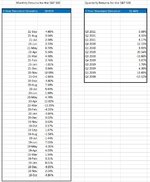NewEnglandMade
New Member
- Joined
- Nov 19, 2021
- Messages
- 2
- Office Version
- 2019
- Platform
- Windows
Good Evening All,
I have been able to successfully calculate the 3 Year Standard Deviation for the S&P 500 using monthly data. The figure I obtain coincides with outside data vendors and I assume is correct. When I attempt to calculate the 3 Year Standard Deviation on the same Index, over the same time period, only using quarterly data, I get a different number. is there a way to adjust so the numbers coincide?
I have attached a spreadsheet with data for both monthly (36 months) and quarterly (12 quarters)
Looking for a way to get the same figure for the 3 Year Standard Deviation
Thanks
Doug
I have been able to successfully calculate the 3 Year Standard Deviation for the S&P 500 using monthly data. The figure I obtain coincides with outside data vendors and I assume is correct. When I attempt to calculate the 3 Year Standard Deviation on the same Index, over the same time period, only using quarterly data, I get a different number. is there a way to adjust so the numbers coincide?
I have attached a spreadsheet with data for both monthly (36 months) and quarterly (12 quarters)
Looking for a way to get the same figure for the 3 Year Standard Deviation
Thanks
Doug






